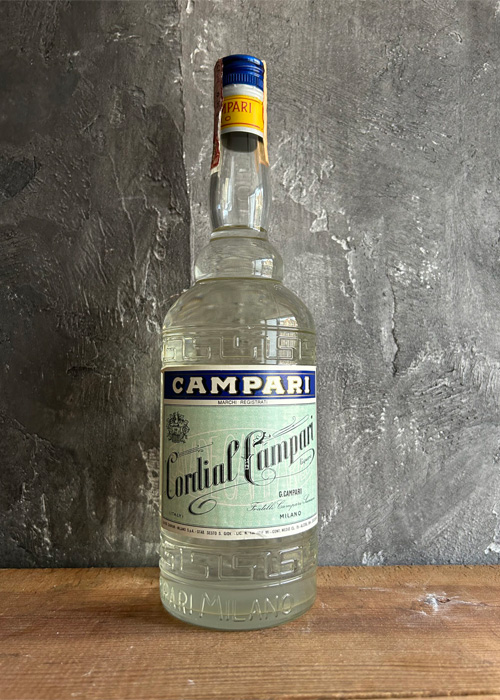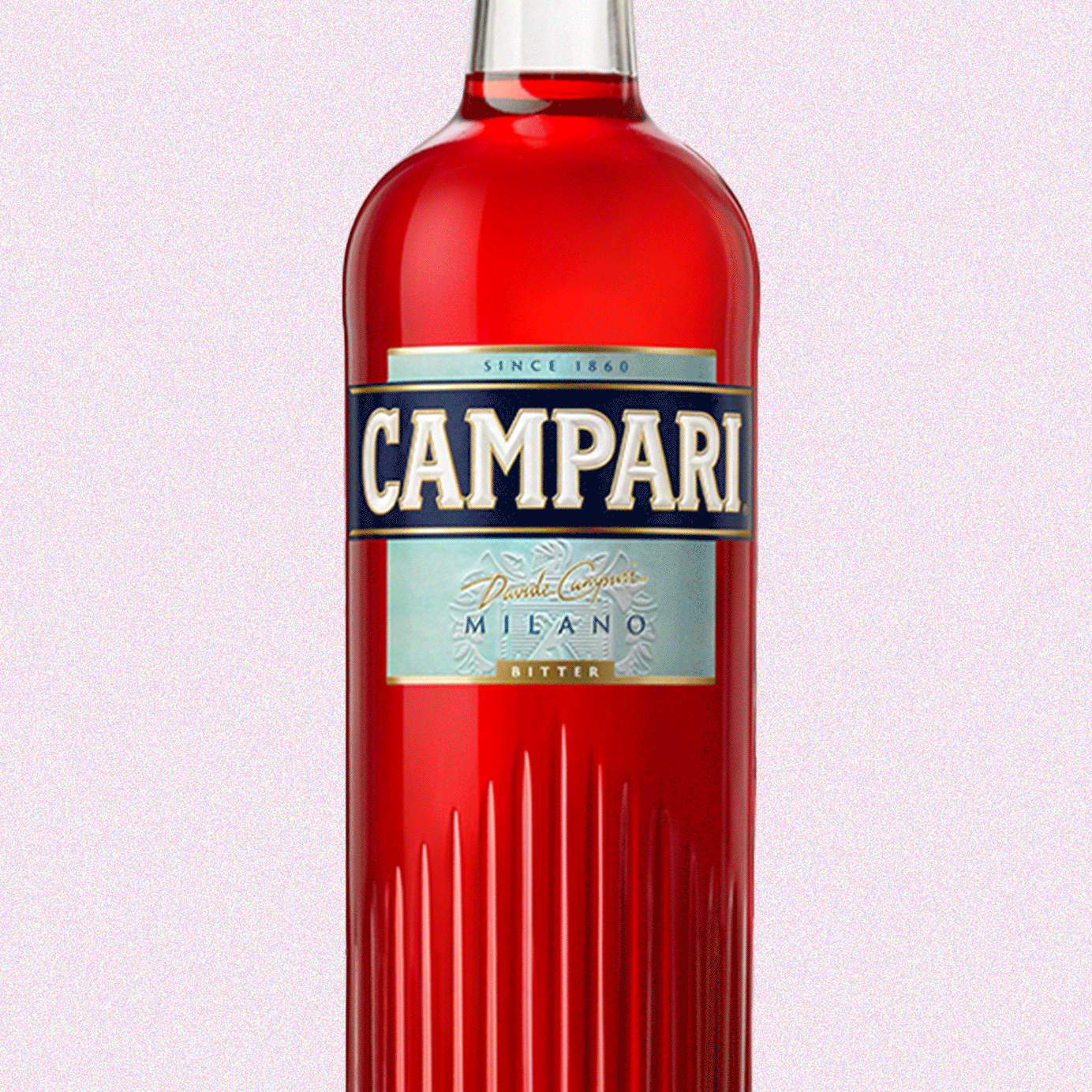There are few liquids that are essentially alcoholic categories unto themselves. Sure, Guinness is an Irish stout, but it’s really just Guinness — nothing else will suffice. The same is true for Chartreuse, Maraschino, and St-Germain. Then there’s Campari, the Italian bitter apéritif. Negroni recipes don’t say “one ounce Italian bitter,” they say “one ounce Campari.”
And yet, Campari is not the only product that has had the Campari label on it.
As recently as 1992 there was a white-labeled, raspberry-flavored Campari simply known as Cordial Campari. Though not produced any longer, today it’s making a comeback among vintage enthusiasts.
Aperitivo to After-Meal
While Gaspare Campari famously invented his namesake bitter in Novara, Italy, in 1860, it was his son, Davide, who created Cordial Campari.
Besides the iconic red bitter, the brand was already offering plenty of other bitters liqueurs at Caffè Campari, the brand’s namesake bar that opened in 1867 in the newly completed Galleria Vittorio Emanuele II in Milan.
“At that time what was missing was a sweeter option for the consumers,” says Mattia Carlozzo, Campari Group’s global managing director of Italian icons.
In trying to create something, Davide Campari took inspiration from the culinary scene in France, where he had apprenticed with master liqueur-makers. His vision was for a French cordial with an Italian touch. He came up with a raspberry-flavored dessert liqueur that was first tested on regulars at the Caffè.
“Even though we have, in the Galleria Campari archive, several menus that see Cordial Campari as an ingredient for different cocktails, the product was mainly consumed neat in a small glass,” Carlozzo says. It was a hit and Cordial Campari was officially introduced in 1886. “With the introduction of this new product, Campari was able to offer a [drink] from the aperitivo time to the after-meal occasion.”
Two years after the launch, Cordial Campari was presented internationally at the Exposición Universal in Barcelona. By the next century, Campari was booming, thanks in large part to Davide’s vision. He opened the company’s first production plant near Milan in 1904 and, soon thereafter, began exporting liqueurs to other European countries and eventually overseas. By 1930, Campari had registered the trademark Cordial.
‘White’ Campari
The first time I saw a bottle of Cordial Campari it was startling. I was staying at a swank hotel in Berlin a few years back where each night, before heading to my room, I’d retire with a nightcap at the bar. It was a quality bar, a modern bar, certainly not a vintage bar, but one day I spied something unusual amid a sea of modern amari:

A Campari bottle, the lettering written in the brand’s custom font, yet the label was completely white aside from navy blue accents. And the liquid inside was clear. It was jarring to me. What was this strange thing, I wondered?
I asked if I could have a glass of the “white Campari,” not knowing what else to call it. The German bartender served me, having to fresh-crack the tax stamp on what I soon saw was a 1960s bottle. If I recall, it only cost a mere 5 euros in a city typically known for high booze prices. Maybe they were just trying to unload old stock.
Its flavor was unexpected and a bit jarring, too. Hardly bitter but fruity and a little sweet, with deep, dark berry notes, and viscous on the palate. It was a great nightcap and I made it my tradition to have “white Campari” every single night I returned home to that hotel.
Perhaps the same “Bizarro World” factor that initially enticed me is why it has begun to garner interest from certain vintage spirits collectors.
“It’s not hot like ‘bug juice’ Campari,” says vintage spirits dealer Jonah Goodman, referring to Campari that used to be dyed red via cochineal bugs, and sells for a pretty penny still today. “Many beverage directors enjoy having [Cordial Campari], but it’s still a geeky, in-the-know thing.”
“This choice [to discontinue Cordial Campari] was influenced by both the growing demand for beverages in the bitter flavor spectrum and the high production costs associated with the raw materials.”
Goodman claims some top bars have begun to use the Cordial Campari in vintage cocktails, like Japan’s Bar Standard, though most serve it neat. Cocktail historian David Wondrich recommended using “the now-rare” ingredient in making The Rose, a Parisian spring cocktail, during his popular early pandemic drink-making series the Lo-Fi Lush Hour, while Belgian bartenders Daan Van de Velde and Hannes Matthys use it for a homemade creation they call Lost and Found.
His best customers these days remain home consumers, says Goodman, who are grabbing them up from him. He sources his bottles mostly from European markets, closed-down bars trying to unload inventory, but especially off-the-beaten path villages that seemingly haven’t caught up to the times.
“It’s much more often available in Europe, sitting on shelves,” he says. “It’s one of those things just gathering dust in small towns.”
The Bitter Flavor Spectrum
In the 1990s, Campari Group made the decision to discontinue production of Cordial Campari. This was around the time the company also decided to start acquiring other brands, sometimes in other categories, like SKYY Vodka. The brand also went all in on amaro and other bitter liqueurs, acquiring Cynar, Cinzano, and Crodino, a bitter soda. (It’s since added Averna, the country’s second best-selling bitter liqueur.)
“This choice [to discontinue Cordial Campari] was influenced by both the growing demand for beverages in the bitter flavor spectrum and the high production costs associated with the raw materials,” says Carlozzo.
With the boom in the amaro category thanks in some part to the cocktail renaissance of the 21st century, it’s hard to argue Campari made a bad decision. Today, Cordial Campari is no longer produced or available in any markets worldwide — except the vintage marketplace, which is something Carlozzo and his cohorts track.
“I would be surprised if they re-introduced a Cordial, as they are going in the opposite direction these days, looking to age in oak.”
“Vintage bottles and vintage drinks are becoming more and more popular among bartenders and spirits collectors,” he says. “Moreover, the desirability of an iconic product like Cordial Campari is increased by the fact that it is no longer on the market and is difficult to find in vintage stores. All these make it even more attractive.”
On the internet, you can currently find bottles of Cordial Campari going for around $200 for newer vintages up to $1,000 for some of the oldest stuff out there (which tends to yellow in color), at top online retailers like Old Spirits Co. and Old Liquor Company, and brick-and-mortar stores like Manhattan’s Astor Wines & Spirits, which prices a 1970s bottle at $174, calling it “a highly sought after item in the world of vintage spirits.” (For comparison, “red” Campari of a similar age goes for some two to three times as much.)
Having said that, and despite this unexpected renaissance, Campari claims it has no interest nor plans in reviving Cordial. Goodman doesn’t think they are playing coy.
“I would be surprised if they reintroduced a Cordial, as they are going in the opposite direction these days, looking to age in oak,” he says, pointing out Campari Cask Tales, a 2018 release that aged Campari in bourbon barrels, courtesy of another brand now in Campari Group’s portfolio, Wild Turkey. A new Cask Tales release adds two additional bottles of Campari that have been aged in fellow portfolio partners Appleton Estate rum and Espolon tequila barrels.
“Currently, given the company’s strategic direction, there haven’t been any discussions on [reviving Cordial Campari],” Carlozzo says. “However, the future might bring unexpected twists and turns.”
